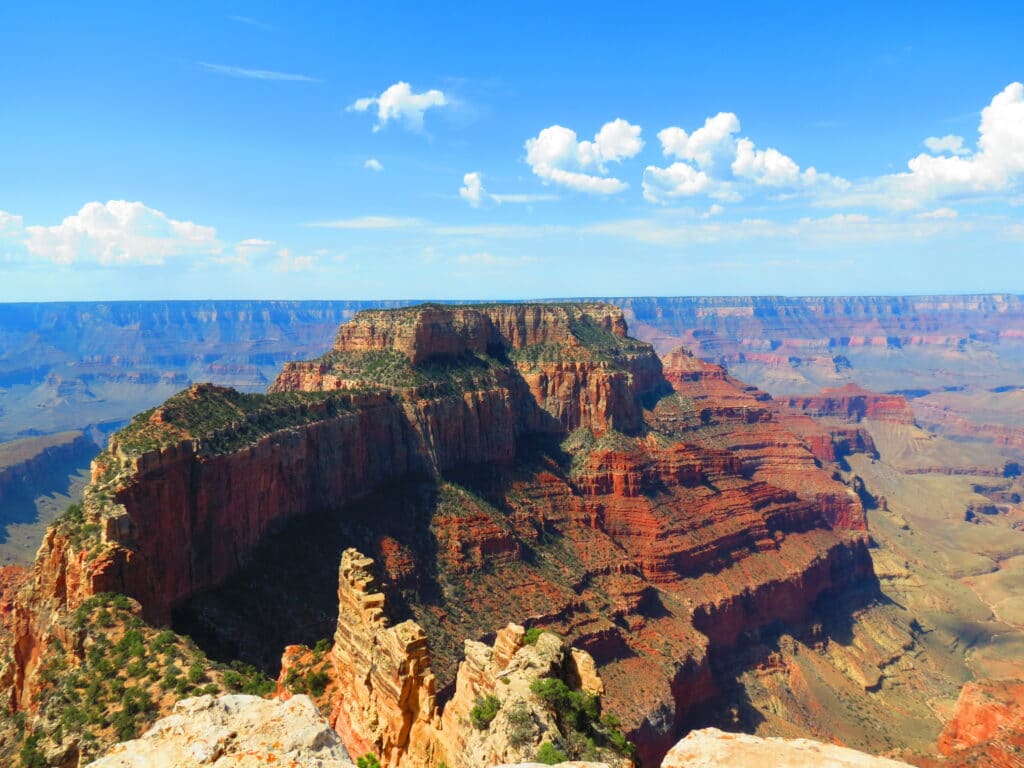
How to Make the Most of One Day in Grand Canyon National Park – South Rim
- Robert Fayette
- Last Modified June 27, 2022
- First Published on December 30, 2020
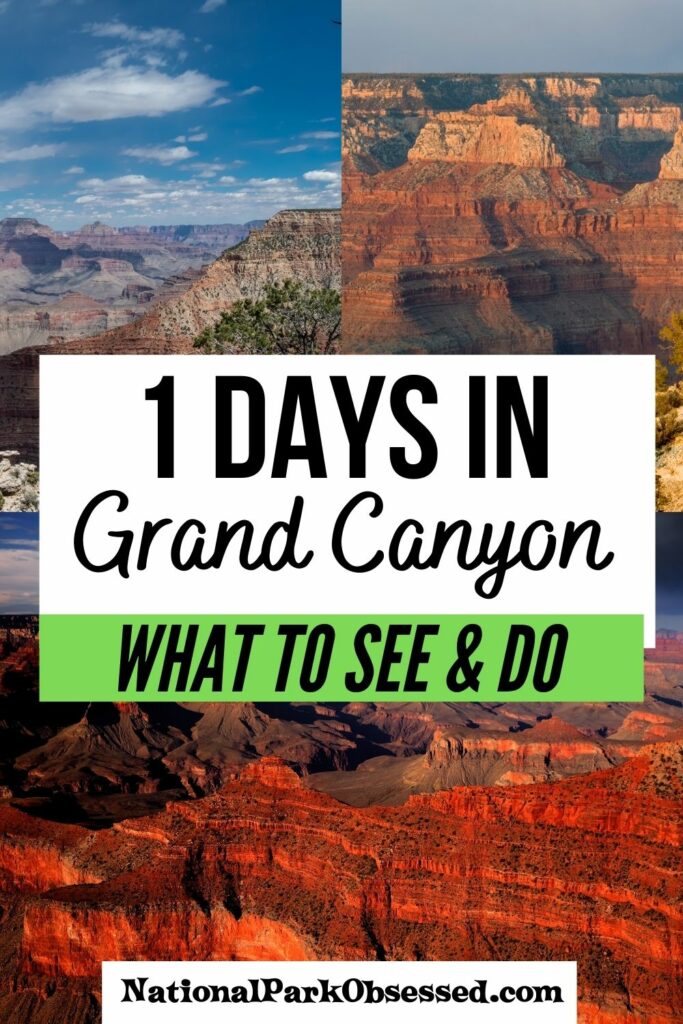
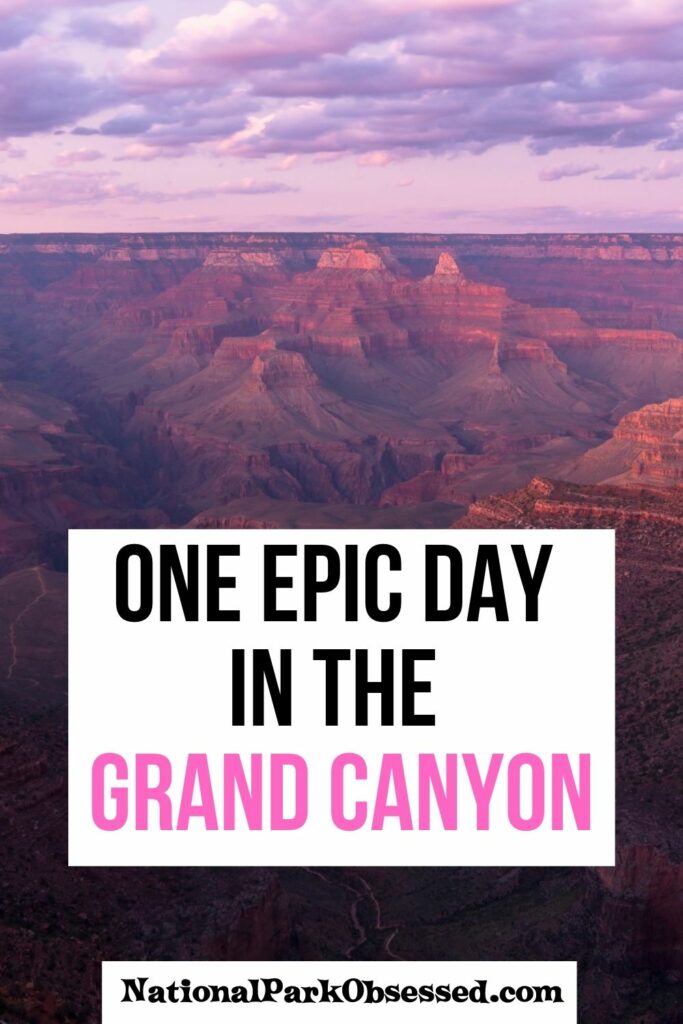
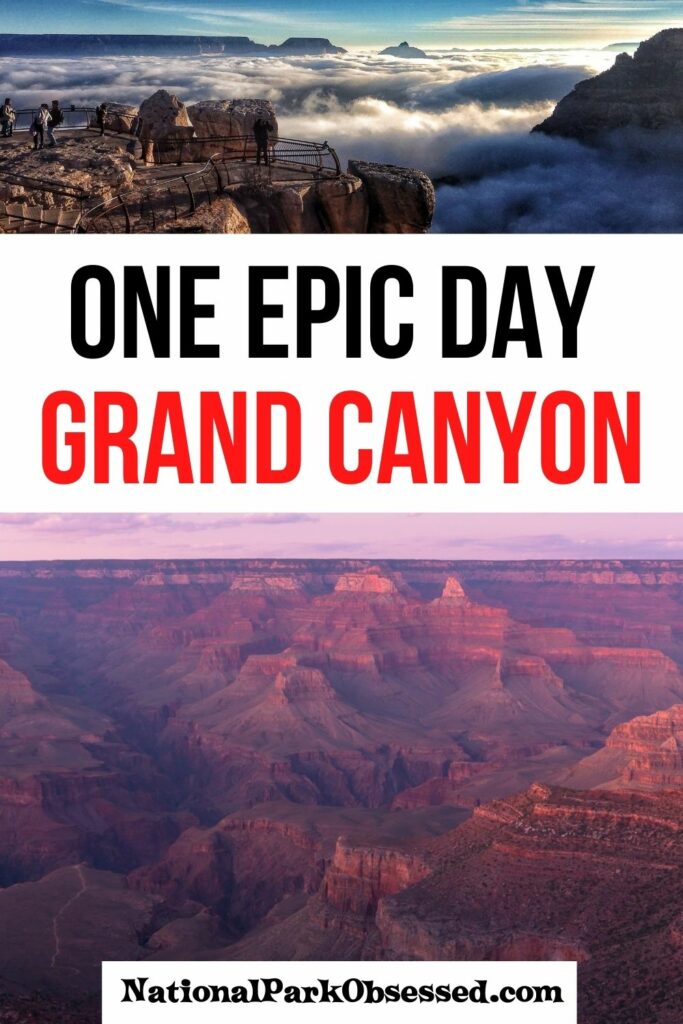
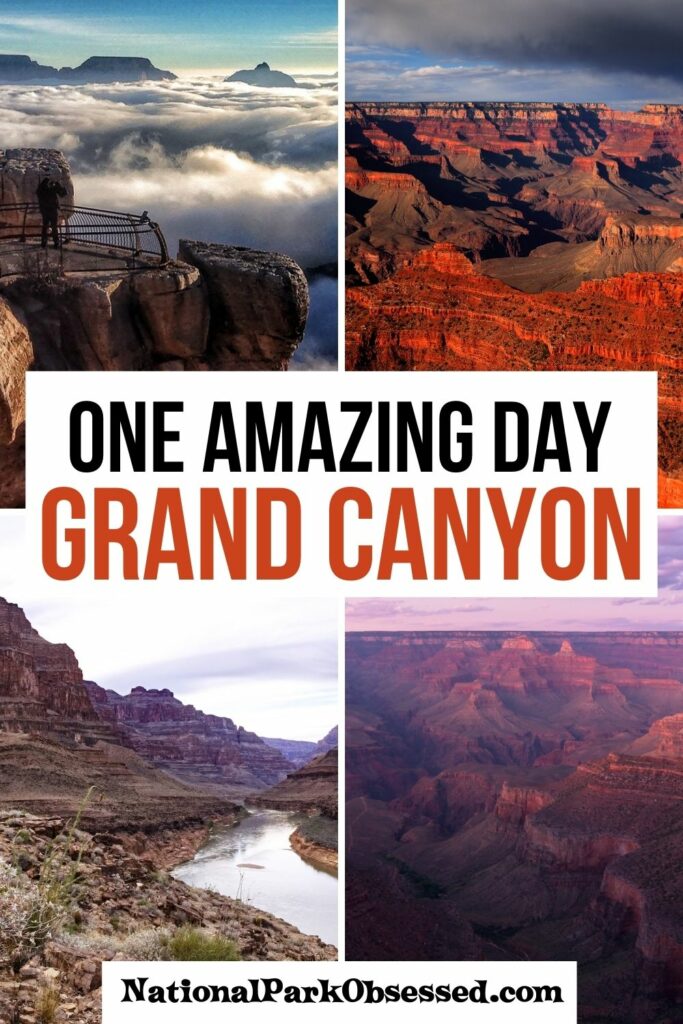
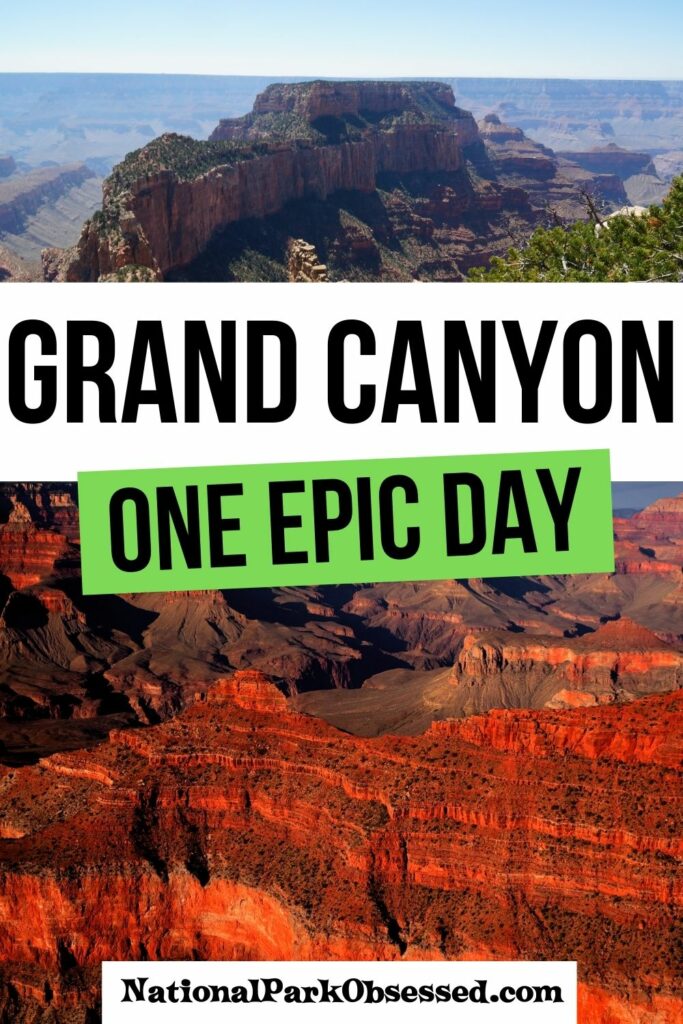
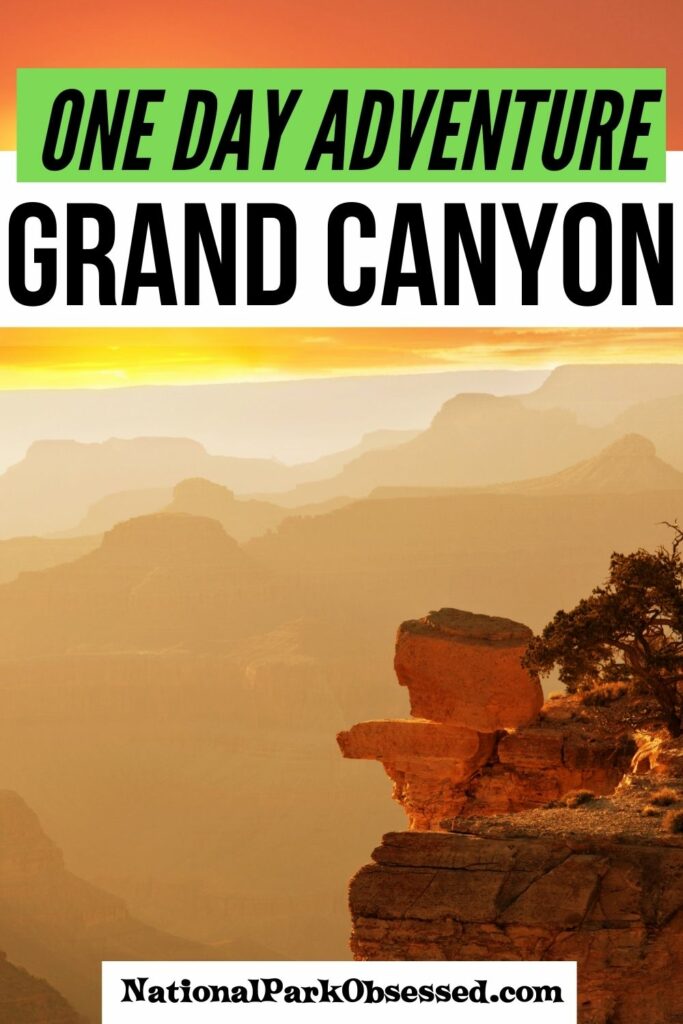

Post Summary: 1 Day in Grand Canyon; One Day in Grand Canyon
There is almost something magical when standing on the rim of the Grand Canyon. You are looking at almost 2 BILLION years of geologic history in a single place. Every day, the Colorado River and its many tributaries flow through the canyon as part of their journey from the Rocky Mountains to the Gulf of California. This constant flow of water has carved the massive work of art known as the Grand Canyon. Located in Northern Arizona, visitors can enjoy panoramic overlooks, multiple hiking trails, and the legendary architecture of the South Rim. One day in the South Rim might sound like a daunting task to many, but achievable. This is our guide on How to Make the Most of One Day in Grand Canyon National Park‘s South Rim.
Best of Grand Canyon National Park in a Nutshell
CAN’T MISS: Things You Can’t Miss in the Grand Canyon
HIKES: Best Grand Canyon Hikes
ONE DAY: One Day in the South Rim
CAMPING: Camping in Grand Canyon National Park
NEARBY PARKS: Bryce Canyon, Petrified Forest, Zion

This post may contain affiliate links, meaning if you book or buy something through one of these links, I may earn a small commission at no extra cost to you! Read the full disclosure policy here

Best time of year to Visit Grand Canyon’s South Rim
The best time of the year to visit the Grand Canyon’s South Rim is during the Spring and Fall months. The temperature and humidity average between the low 50s to the low 70s during these seasonal months. Anticipate an early morning arrival to the park as the park is busy on the weekends and parking will fill up quickly.
The Winter months blankets the South Rim and temperatures will average daily between the mid-teens and high-twenties. Snow is expected and chains might be required in order to visit.
The Summer months can experience moderately warm temperatures exceeding 80-degrees. If you’re planning on visiting the park during the Summer months, pack accordingly with plenty of water to avoid dehydration.
How many days in Grand Canyon National Park?
There is no right or wrong answer to this question. Some people hold the opinion that “after gazing the canyon for 3 minutes from the rim, you have seen it all.” Others could spend years exploring the trails of the Grand Canyon and never get bored. The real key is to make the most of the time you have and to do what interests you. There is no wrong way to see the Grand Canyon.
If you aren’t interested in hiking at the Grand Canyon, then don’t. Going down is optional, coming back up isn’t. You do, you.
Jennifer, the founder of National Park Obsessed, once visited the Grand Canyon. The plan was to do some serious hiking and hike a few of the lesser known trails as part of a month long road trip. She got up to the Grand Canyon and just wasn’t in the mood to hike. So she didn’t. She found plenty of above the rim activities and took nice afternoon nap in her hammock.
If you have one day, then this is the guide for you. If you have longer than a day this is a good place to stat planning but be sure to check out our first visit must see guide for ideas on other things to do in the Grand Canyon.
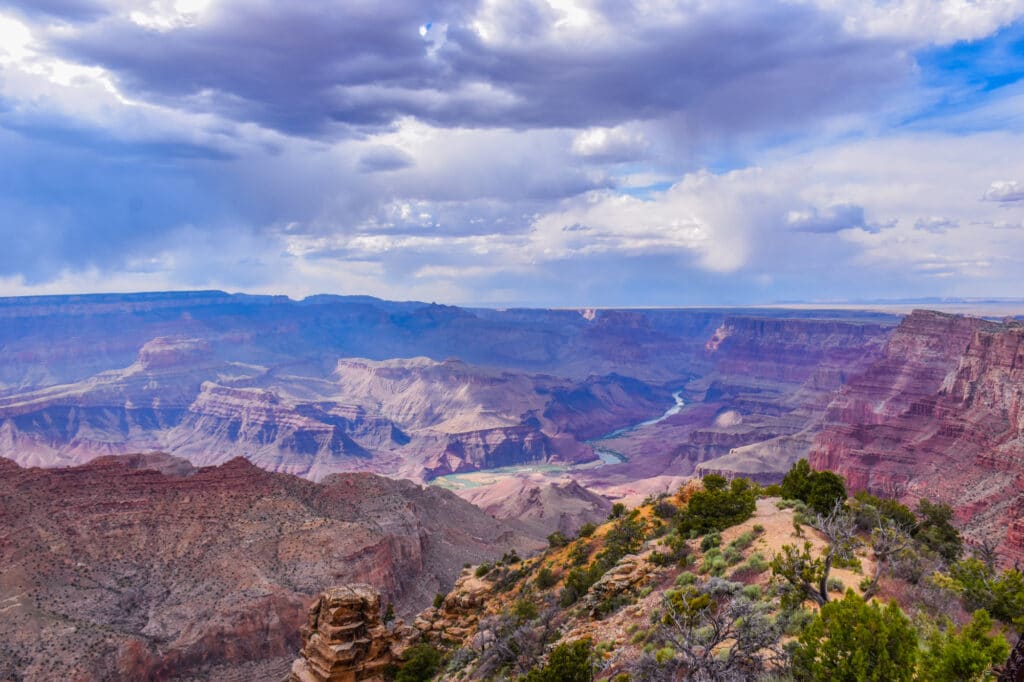
Getting to Grand Canyon
The closest airport to Grand Canyon National Park is Flagstaff Pulliam Airport (FLG). This small commercial airport is located about 1.5 hours from the park. The closest major airport is Phoenix Sky Harbor International Airport (PHX), located four hours south of the park entrance. If you are road tripping through several of the nearby California, Nevada, New Mexico, or Utah National Parks, airport options include Las Vegas (LAS), Los Angeles (LAX), Salt Lake City (SLC) or Albuquerque (ABQ).
There are several transportation operators who run daily shuttles from Williams or Flagstaff to the south entrance of the park and from Las Vegas. Another available option is the Grand Canyon Railway, that offers daily trips from Williams to the Grand Canyon National Park Depot located inside of the park.
Estimated Drive time to Grand Canyon National Park from major cities
- Phoenix, Arizona – 3.45 hours
- Las Vegas, Nevada – 4.25 hours
- Albuquerque, New Mexico – 6 hours
- Los Angeles, California – 7.25 hours
- Salt Lake City, Utah – 9.25 hours
Estimated Drive time to Grand Canyon National Park from nearby National Parks
- Petrified Forest National Park – 3 hours
- Zion National Park – 4.5 hours
- Arches National Park – 5 hours
- Saguaro National Park – 5 hours
- Great Basin National Park – 5 hours
- Mesa Verde National Park – 5.5 hours
- Joshua Tree National Park – 5.5 hours
- Bryce Canyon National Park – 5 hours
- Canyonlands National Park – 6 hours
- Capitol Reef National Park – 6.5 hours
- Black Canyon of the Gunnison National Park – 7 hours
- Great Sand Dunes National Park & Preserve – 8.5 hours
Best Guided Day Tours in Grand Canyon National Park
If you want to make your trip to Grand Canyon as easy and simple as possible, check out these amazing Grand Canyon Day Trips:
Where to Stay in Grand Canyon National Park?
The Grand Canyon Canyon is one of the busiest National Parks and lodging and camping is at a premium. Reservations for most of the in-park hotels and lodges can be made up to 13 months in advance and do fill up months in advance. Make your reservations AS FAR IN ADVANCE as possible.
Lodging in Grand Canyon National Park
Grand Canyon South Rim Lodging
There are several hotel options and three campgrounds on the South Rim of the Grand Canyon. Here are our recommendations for in park lodging:
- El Tovar Hotel – El Tovar is the HISTORIC hotel of the Grand Canyon and has a elegant European feel. This hotel is a National Historic Landmark. Rooms from $189/night: Book on Hotels.com or Read the Read the TripAdvisor Reviews.
- Kachina Lodge – Kachina Lodge is a more modern lodge on the South Rim. The rooms are more modern sized and come with traditional amenities. Rooms from $258/night: Book on Hotels.com or Read the TripAdvisor Reviews.
Coolest Airbnbs near Grand Canyon National Park
- Ultimate Stargazing Experience – Sleep under the stars in comfort with this cute dome tent. The dome has a clear roof so you have a 360 degree view of the stars. Rooms from $179/night: Book on Airbnb.
- Grand Canyon Bungalow – This large bungalow is perfect for families or large groups looking to stay near the rim . Rooms from $175/night: Book on Airbnb.
- A-Frame with Mountain Views – Stay in this amazing A-Frame cabin in Coconino Forest. Rooms from $175/night: Book on Airbnb.
If none of these strike you fancy check out these other amazing Grand Canyon Airbnbs.
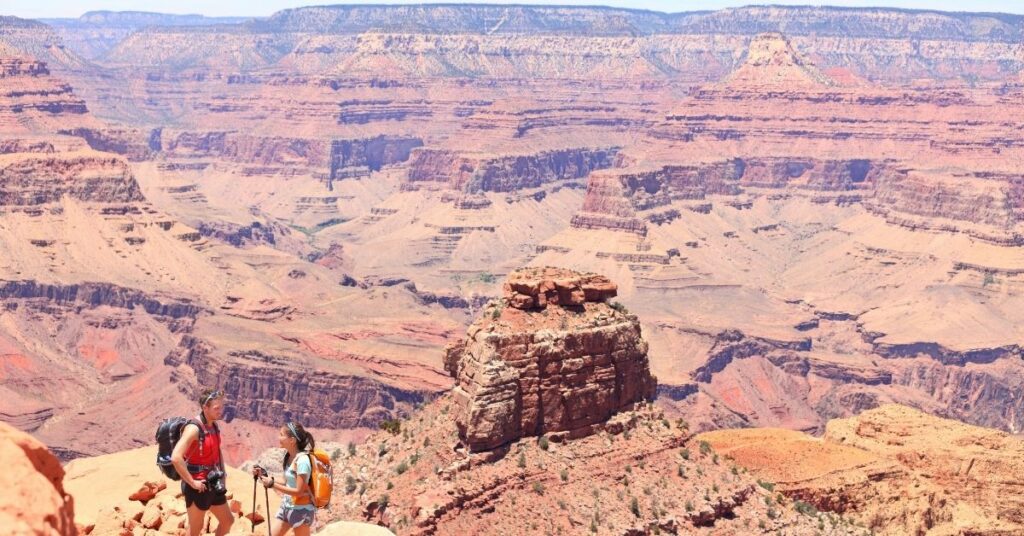
What to pack for a visit to Grand Canyon National Park?
- America the Beautiful National Parks Pass: Grand Canyon National Park costs $30 for a 7-day pass. If you intend to visit more than 3 National Park Services sites in a year, the America the Beautiful Pass will more than pay for itself. >> Get Your Pass HERE
- National Park Passport – The National Park Passport Book is the cheapest and best souvenir of your national park adventures. This book makes it easy to collect the National Park Cancellation stamp have the date of your visit and make it easy to track when you visited each national park service unit. >>> Buy your parks passport HERE
- Learn more about the National Park Passport Program
- Refillable Water Bottles – Do your part to reduce litter in our parks by bringing a refillable water bottle with you. A reusable and refillable water bottle can save you a lot of money and really help the environment. Here are my favorite water bottles
- Hydration Bladder – If you are hiking longer distances, a hydration bladder is the best way to hike with significant quantities of water. It is a rare hike when I don’t bring a full bladder with me.
- Snacks – There are limited services in the park. So pick up all your snacks before you go. Pack a couple of different options so you are prepared for any craving.
- Fruit: Pick hard fruits such as apples or pears. These hold-up in the heat and in packs without getting squished to mush. Another option is freeze-dried fruit. Freeze-dried strawberries are the BOMB. They are crunchy, sweet and the best part is they are lightweight and yummy. These are my new favorite trail snack.
- Vegetables: Cucumbers and carrots hold up well during hiking and in a hot car.
- Granola Bars: Take your favorite non-coated in chocolate granola bars. Anything coated in chocolate will melt and be a sticky mess. My favorite is a selection of Cliff Bars. They are great even when squished.
- Sunscreen – You don’t want to get burned on your visit.
- Lip balm – Your lips need just as much sun protection as your skin does.
- Sunglasses – Similar to sunscreen, you need a good pair of polarized sunglasses to protect your eyes from the glare of the sun.
- Hat – Hats are another sun protection device. A hat can keep the sun off your face and neck and help minimize the need for sunscreen while on the trail.
- First aid kit – As with any outdoor adventure, accidents happen. It is better to be prepared and have a compact first-aid kit ready to help with any accidents.
- Headlamp – Always keep a headlamp handy. You never know when you might want it. It can be used for midnight bathroom runs to sunrise/sunset hikes. A good headlamp makes it easy to operate in the dark.
- Shoes – Shoes are probably the most important piece of gear to any hiker. Hiking shoes should be seen as an investment. On the trail, your feet are your transportation and a solid pair of hiking shoes help support your feet and can prevent injury.
- Hiking Day Pack – A good day pack is the best way to transport all your gear when hiking. I highly recommend getting a backpack that is designed for outdoor use. These packs come with handy pockets and straps. My 40 L day pack has a pocket for my water bladder and a clip to hold the water line in place.
- National Park Obsessed Shirt – Share your love of the National Parks and support National Park Obsessed with a National Park Obsessed T-Shirt.
If you are new to visiting a the National Parks, check out our National Park Essentials Guide to get your started.
One Day in Grand Canyon
1 Day in Grand Canyon Itinerary
- Visit the historic Kolb Studio and Hopi House
- Explore the 13-mile Rim Trail
- Mather Point
- Experience the inner canyon from the Bright Angel Trail
- Climb the historic Desert View Watchtower
- Explore the South Rim through the free shuttle system
- Photograph sunrise at Moran Point
- Visit Hermits Rest
- Explore the Grand Canyon Village
- Trace the canyon history along the Trail of Time
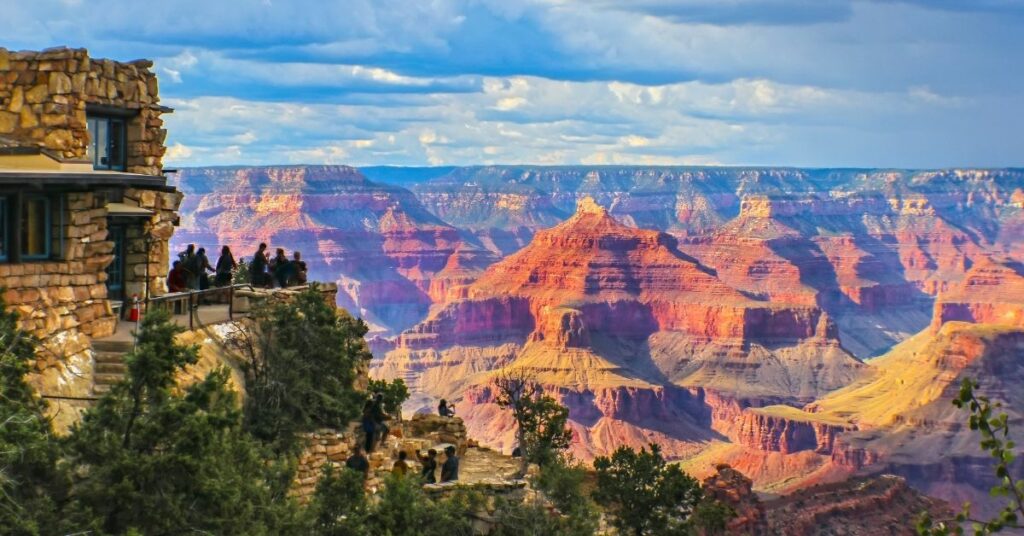
How to spend your day in the Grand Canyon
Kolb Studio is a park icon located on the Rim Trail near the Bright Angel Trailhead. It was originally operated as a photography studio and family home by brothers Ellsworth and Emery Kolb from 1904 until 1976. Operated by the Grand Canyon Association, Kolb Studio has evolved through near destruction and refurbishment efforts into a reimagined art gallery and bookstore.
The 13-mile Rim Trail begins near the South Kaibab Trailhead and proceeds west until it ends at Hermits Rest. While it is a relatively flat and paved trail, hikers are recommended to carry with them enough water and snacks. The red shuttle stop at Hermit’s Rest will return you to the Grand Canyon Village. The shuttle operates between March 1 through November 30.
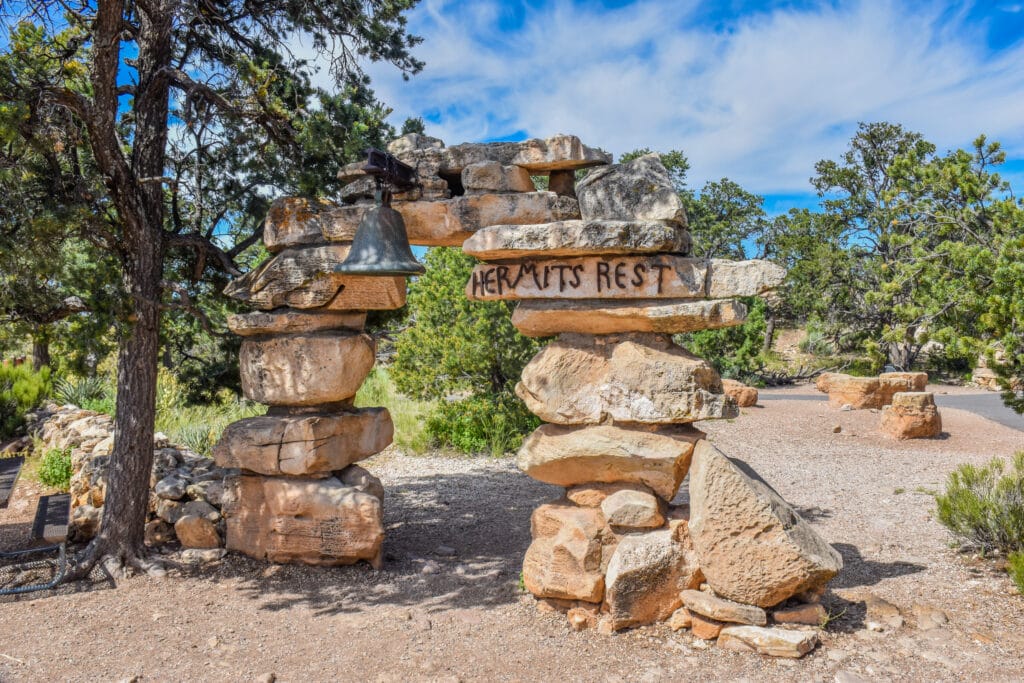
Mather Point is an overlook adjacent to the visitor center and its parking lot. The Mather Point overlook provides visitors with panoramic views of the canyon for as the eyes can see. The Coconino Sandstone and Kaibab Limestone rock layers usher in stunning views one-mile below into the canyon, while the North Rim of the canyon appears in the distance. The overlook, consisting of two lookout points was named for Stephen Mather, the first director of the National Park Service and one of the first advocates for establishing the Grand Canyon National Park.
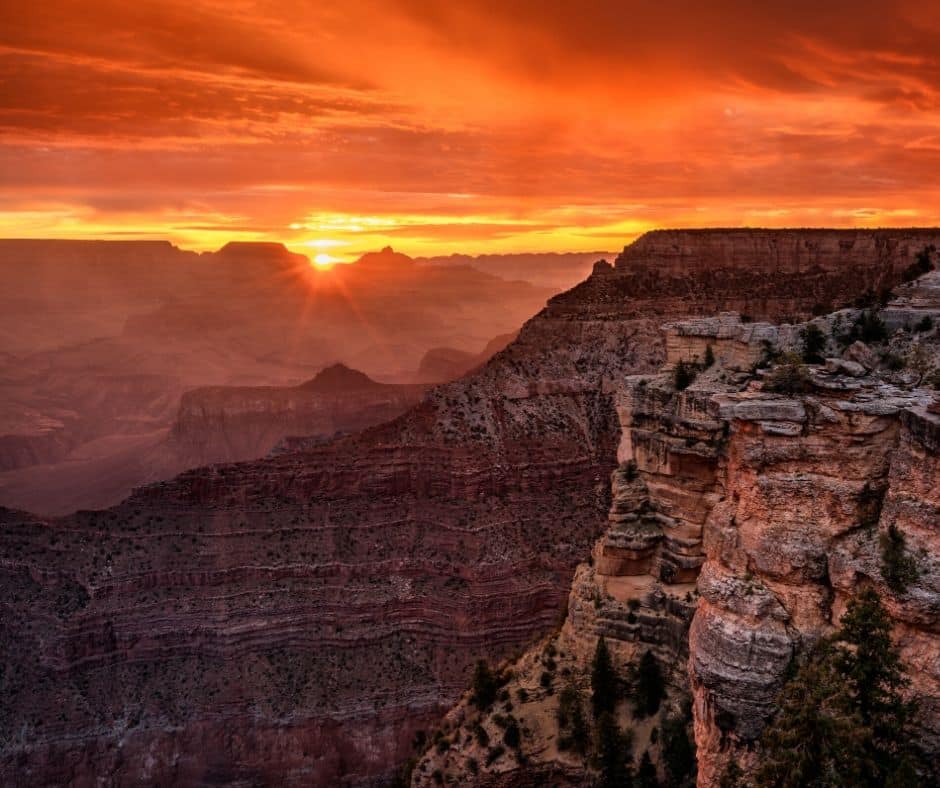
The Bright Angel Trail begins at the Grand Canyon Village. The 8.0 mile trail descends 4,800 feet from the southern rim to the Colorado River. The most popular hiking trail among park visitors, the trail offers stunning views of the magnificent colors which make-up the inner layers of the canyon. The trail connects hikers with the Tonto Trail, The Plateau Point Trail and River Trail along the way and mule riders making their way to Phantom Ranch. Multiple rest house’s are located on the trail prior to reaching the Colorado River.

Desert View Watchtower provides park visitors with their first view of the canyon after entering through the Desert View Entrance gate. The Desert View Watchtower is a 70-foot tall, four story circular-cone structure located near the east entrance of the park. Designed my Mary Coulter to resemble that of an Ancient Indian pueblo ruins, the watchtower promotes the spirit, art and cultural history of the Euro-American and Native Americans who once called the Grand Canyon area their home.
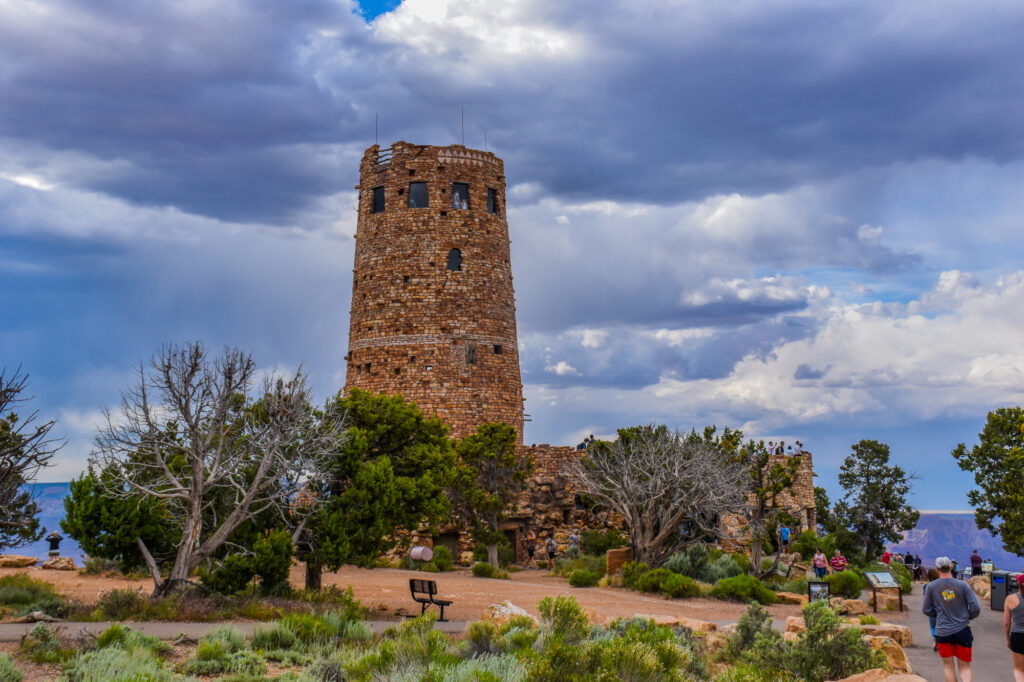
Navigating your way through the South Rim in one day possible from the free shuttle system. The Hermit Road Route (Red Route) provides transportation from the Grand Canyon Village west to Hermits Rest. This route is popular among photographers chasing panoramic sunset views of the canyon. The Village Route (Blue Route) provides transportation throughout the Grand Canyon Village with a stop at the Visitor Center. The Kaibab Rim Route (Orange Shuttle) transports visitors and hikers east from the Visitor Center to the South Kaibab Trailhead.
Moran Point is an impressive overlook in the park, popular among artists and photographers inspired to document the landscape and colors of the canyon. It is located at the end of a small road just north of Desert View Drive, 17-miles east of Grand Canyon Village and 7-miles west of Desert View. Colors of sedimentary rock and the Hakatai Rapids are visible below. This is a popular location that tourists enjoy early in the morning and prior to sunset as the light creates moving images reflecting off the magnificent colors of the canyon wall.
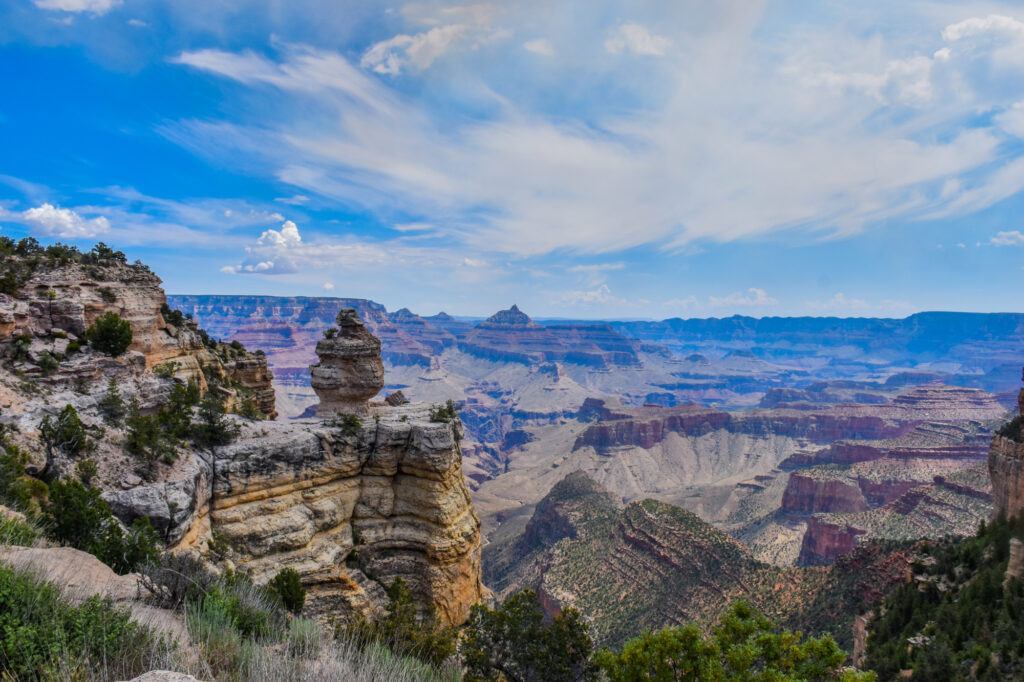
Hermits Rest is a historic structure that was built in 1914 by Mary Coulter. It is located at the western edge of the park where the Hermits Rest (Red) Shuttle route ends before returning to Grand Canyon Village. Since its opening in 1914, it has provided shelter and a small snack bar for visitors exploring the western edge of the park. Appearing as a natural stone formation, Hermits Rest combines the spirit of the frontier and solitude, highlighted by an indoor fireplace.

The 9-mile Hermit Travel begins about a 1/4 mile from the shuttle stop at Hermits Rest. The trail offers a challenging opportunity for experienced hikers on that descends over 4,200 feet to the Colorado River.
The Grand Canyon Village is the hub of the South Rim. Located several minutes from the South Entrance in Tusayan, visitors can visit the historic Kolb Studio and Hopi House as they begin their day in the park. Located in the heart of the village, the Grand Canyon Railroad Depot arrives in the park following a one-way trip from Williams, AZ. Visitors can board the Red and Blue shuttle routes or access the Bright Angel Trail adjacent to the Bright Angel Lodge.
The Trail of Time begins just west of the Yavapai Geology Museum. The 1.7 mile trail is a portion of the 13-mile Rim Trail that spans between the Yerkamps Visitor Center and Yavapai Geology Museum. Serving as a tribute to the rich geological history of the canyon, the trail is commemorated through brass markers positioned at every meter signifying one million times of time. Visitors are provided the opportunity to learn and understand the geologic periods of the canyon through the colors that line its wall.
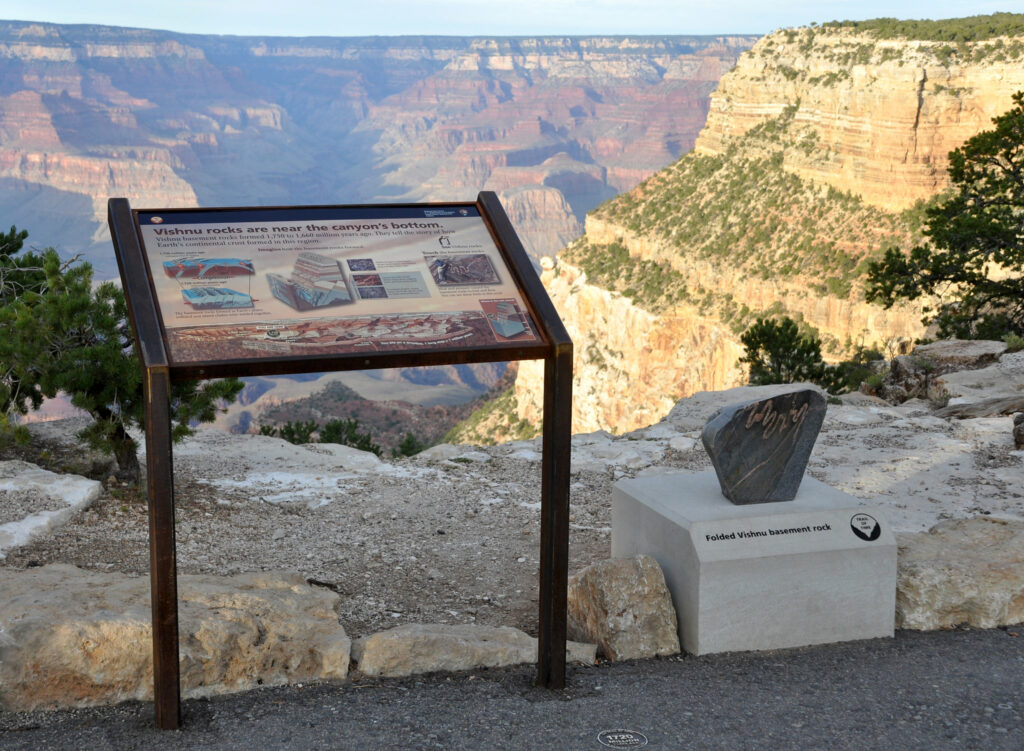
Final Thoughts on spending 1-Day in the Grand Canyon
I hope this guide helps you plan your 1 day in the Grand Canyon.
If you need any gear recommendations be sure to check below.
If you are looking for advice on other types of outdoor gear specific guides:
Here are some other National Park gear you might like:
- 29 Phenomenal National Park Gifts for Park Lovers
- 19+ Junior Ranger Gift Ideas
- Epic US National Park Wall Maps to help you keep track of your travels
Pin for Later: How to Make the Most of One Day in Grand Canyon National Park’s South Rim

Robert Fayette
Hi, I'm Jennifer!

Welcome to the wonderful world of National Parks. I'm here to help you plan your NEXT amazing adventure through the United States National Parks and beyond. I want the national parks to be accessible to all.
I live in Tennessee, and when I'm home, you can find me hiking in the Smokies and the Cumberland Plateau.
58/63 National Parks
250+/423 National Park Units
Want to know more? Start Here.
ACKNOWLEDGEMENT OF LAND
On this site, we promote travel to the United States and beyond that are the traditional lands of Indigenous and First Nations peoples.
With respect, I make a formal land acknowledgment, extending my appreciation and respect to these lands’ past and present people.
To learn more about the people who call these lands home, I invite you to explore Native Land.
DISCLAIMER
National Park Obsessed assumes no responsibility or liability for any errors or omissions in the content of this site (NationalParkObsessed.com). The information contained in this site is provided with no guarantees of completeness, accuracy, usefulness or timeliness. You are encouraged to conduct your own due diligence before acting on the information provided on this site and should not rely on the opinions expressed here.
There is an inherent risk in all outdoor recreation activities, the reader assumes all responsibility for their own personal safety.
DISCLOSURE
We are a participant in the Amazon Services LLC Associates Program, an affiliate program designed to provide a means for us to earn fees by linking to Amazon.com and affiliated sites.
Privacy Policy • About Us • Contact
Select stock photography provided depositphotos
Copyright ©2023 National Park Obsessed, LLC
Last Updated on 27 Jun 2022 by Jennifer Melroy



